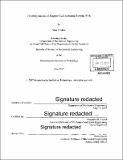| dc.contributor.advisor | Alexandra H. Techet. | en_US |
| dc.contributor.author | Petelina, Nina | en_US |
| dc.contributor.other | Massachusetts Institute of Technology. Department of Mechanical Engineering. | en_US |
| dc.date.accessioned | 2017-12-05T19:17:53Z | |
| dc.date.available | 2017-12-05T19:17:53Z | |
| dc.date.copyright | 2017 | en_US |
| dc.date.issued | 2017 | en_US |
| dc.identifier.uri | http://hdl.handle.net/1721.1/112550 | |
| dc.description | Thesis: S.B., Massachusetts Institute of Technology, Department of Mechanical Engineering, 2017. | en_US |
| dc.description | Cataloged from PDF version of thesis. | en_US |
| dc.description | Includes bibliographical references (page 44). | en_US |
| dc.description.abstract | The hydrodynamics of two robotic fish were analyzed: a low cost toy robotic fish for developing live fish experimental techniques, HEXBUG(TM) Aquabot, and a low cost robotic fish for swarm robotics experiments, Scuba Fish. Both of these robotic fish use a magnet-coil actuation method in order to create caudal fin motion. A velocity imaging technique,, Particle Image Velocimetry (PIV), was used in order to characterize the wake structure created by the tail beat. Both robotic fish were towed through water as a high speed camera recorded the movement of seeding particles around the caudal fin, which are illuminated with a laser. From 2D PIV and 3D Synthetic Aperture PIV experiments for the Aquabots it has been identified that the discrete tail beat from the bang bang control creates vortex pairs at each start or stop motion of the caudal fin. Moreover, the wake structure from the shark Aquabot tail beat creates a wake structure similar to live dogfish sharks. Since the design of the Scuba Fish allowed more control over the motion of the tail, an additional ramp pwm caudal fin control was designed and tested in order to analyze the wake from a continuous tail beat. The results show that the vortex shedding pattern created by the pwm ramp design is different from the bang bang cases; the method creates a negative vortex ring with a small vortex pair at the end of the motion. This suggests that further designs of a continuous control have to be investigated in order to achieve a more real fish-like swimming behavior. | en_US |
| dc.description.statementofresponsibility | by Nina Petelina. | en_US |
| dc.format.extent | 44 pages | en_US |
| dc.language.iso | eng | en_US |
| dc.publisher | Massachusetts Institute of Technology | en_US |
| dc.rights | MIT theses are protected by copyright. They may be viewed, downloaded, or printed from this source but further reproduction or distribution in any format is prohibited without written permission. | en_US |
| dc.rights.uri | http://dspace.mit.edu/handle/1721.1/7582 | en_US |
| dc.subject | Mechanical Engineering. | en_US |
| dc.title | Hydrodynamics of magnet-coil actuated robotic fish | en_US |
| dc.type | Thesis | en_US |
| dc.description.degree | S.B. | en_US |
| dc.contributor.department | Massachusetts Institute of Technology. Department of Mechanical Engineering | |
| dc.identifier.oclc | 1012945524 | en_US |

